The Story
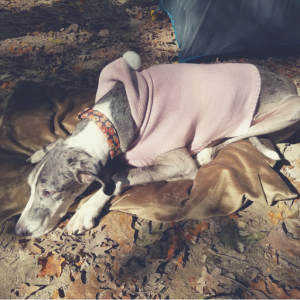 One morning in April of this year, our beloved 7 year old Great Dane, Dylan, suddenly couldn’t walk. At just over 100 pounds, she is actually quite small for her breed. Relatively small as she may be, getting a 100 pound animal to the vet when they can’t walk is no small feat. Fortunately, I had just been certified in canine first aid and CPR which covered how to safely move an injured animal. Unfortunately, we quickly came to realize these certification programs don’t seem to be catered to or tested on giant breed dogs. Everything I had learned that sounded logical at the time, in practice turned out to be completely unrealistic.
One morning in April of this year, our beloved 7 year old Great Dane, Dylan, suddenly couldn’t walk. At just over 100 pounds, she is actually quite small for her breed. Relatively small as she may be, getting a 100 pound animal to the vet when they can’t walk is no small feat. Fortunately, I had just been certified in canine first aid and CPR which covered how to safely move an injured animal. Unfortunately, we quickly came to realize these certification programs don’t seem to be catered to or tested on giant breed dogs. Everything I had learned that sounded logical at the time, in practice turned out to be completely unrealistic.
Makeshift stretchers don’t work. Unless you have an actual stretcher laying around your house, trying to use a wooden board or large blanket is either very difficult or completely impossible. For starters, we do a lot of DIY projects around here…I mean A LOT, so we probably have more scrap wood laying around the house than most. Despite this, we still didn’t have a board that was both thick, long and narrow enough to work. It needs to be thick enough to not risk breaking under the weight of the dog, long enough to support the dog from head to hind region, and this last part was the kicker, narrow enough to get through a doorway. We had plenty of wood that was thick enough and I even ran out a cut down a piece to the right length. The issue came down to the narrowness. If it was wide enough so she’d be comfortable and her long legs wouldn’t be dangling off the ends, then it wasn’t narrow enough to get through a doorway. If it was narrow enough for the doorway, it wasn’t wide enough to keep her legs tucked onto it.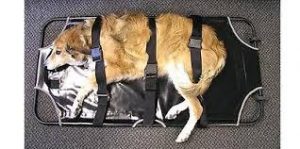
Here’s where my first aid training would have chimed in and said ” but you’re supposed to secure the dog to the board by wrapping an ace bandage or blanket around the dog and board together.” Seems logical, right? Just tuck the dog’s legs in while wrapping the bandage around her and the board and they won’t dangle off the edge. Right? Not really. When you actually try putting this whole “secure the dog to the board” part into practice, it’s completely unrealistic for a giant breed dog. Here’s why:
A conscious and scared dog does not want to lie on its side. If we were talking about a Maltese, it’d likely be easy enough to gently roll the dog onto it’s side and wrap away with the bandage. Anyone with a giant breed dog, however, knows trying to get them to sit, lie down or roll onto its side when it doesn’t want to is a full contact sport. Considering the last thing you want is for the dog to start thrashing and squirming for fear they may injure their spine further, forcing them over was not something we were willing to risk. Even if you’re lucky enough to safely get the dog onto its side, or for arguments sake, say you decide to secure the dog to the board while it’s lying upright, you still have another problem.
Lifting corners of a large, thick board with a scared 100+ pound dog on it is not safe or realistic. Maybe if we had 3 or 4 people to help with this, it would have been more doable. We had 2 people. We’re both in good health and pretty strong but there was no way that bandage was getting under that board. Even trying to lift a corner once was nearly impossible. The dog is scared, the board and dog are very heavy, so one of us is trying to steady the dog and calm her so she doesn’t squirm while the other tries to slightly lift a corner and shove part of the bandage under. Maybe we could have done this once or twice to get a pass or two, but first aid training shows wrapping the bandage over and over again so the whole dog is secured to the board and is not at risk of falling off if they suddenly squirm. NOT GONNA HAPPEN. As much adrenaline as there is pumping through your body to give you the strength to do it, there’s probably more pumping through your dog. Every time you lift one of those corners even a hair, it’s going to scare the dog and make them squirm to get off that board. Getting a dozen or more passes of the bandage under the board just isn’t feasible. And that’s assuming you have that much bandage or long enough blankets in your house to even attempt it.
So the board is a bust. Now what? We still have giant blankets to try to use as a sling. That should work, right? Sort of. We did end up getting her into the car with this method but it was incredibly difficult and we really risked injuring her further but didn’t have much of a choice at the time.
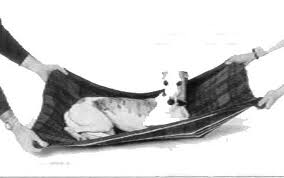 Using a blanket as a sling will likely make the dog squirm even more. When we slid the blanket under her entire body and tried to lift, her legs kept awkwardly bunching under her as she squirmed and it was impossible to move her. As an alternative, we slid the blanket just under her midsection. This she seemed comfortable with and really didn’t squirm much. There was another problem though.
Using a blanket as a sling will likely make the dog squirm even more. When we slid the blanket under her entire body and tried to lift, her legs kept awkwardly bunching under her as she squirmed and it was impossible to move her. As an alternative, we slid the blanket just under her midsection. This she seemed comfortable with and really didn’t squirm much. There was another problem though.
Using a blanket as a sling requires A LOT of upper body strength. Particularly when going up and down stairs and trying to lift the dog into the car. Specifically because Great Danes have such long legs, leaving her legs hanging out of the sling, while it made her comfortable, meant we had to not only lift her body off the ground, but we also had to lift her high enough so her legs cleared whatever we were walking over. Stairs, car doors, etc. One thing that helped was we called ahead when taking her to the vet (and later the emergency room and after that a specialist) so they were able to have a gurney come out and meet us at the car to slide her from one to the other. Even taking her from our living room to the car in our driveway required a break or two of setting her down to regain our arm strength. Again, we’re healthy, fairly strong people so it got the job done ultimately but it was not easy or pretty.
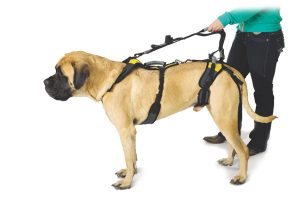 Is there a better solution? Yes! Keep in mind, I am not a Veterinarian. This is just what has worked for us since the methods listed above were not ideal. You should definitely speak with your Vet, do your own research and choose methods according to what’s best for your dog and your situation.
Is there a better solution? Yes! Keep in mind, I am not a Veterinarian. This is just what has worked for us since the methods listed above were not ideal. You should definitely speak with your Vet, do your own research and choose methods according to what’s best for your dog and your situation.
That said, I wish I had known about the Help ‘Em Up Harness beforehand. The specialty center where Dylan had her surgery sold them. It is the best solution we’ve found to date. It quite literally lets you quickly and easily pick your dog up like a large piece of luggage that has a shoulder strap. The shoulder strap is sold separately but I highly recommend getting it along with the full harness. As hard as it was for two of us to move our dog before, now that we have this harness and the shoulder strap, I know I can move her by myself if I have to.
We actually use it as her everyday harness when we take her for walks now because she seems more comfortable in it and it doesn’t pull at her neck at all. As much as I loved the Gentle Leader because it was perfect for controlling large dogs safely, we’ll never use any collar or lead that controls the dog from the neck or head again. At least not with Great Danes. Their necks are too long and their spine is already under enough stress from their large heads. It turned out that Dylan has Wobbler’s (which we never knew about because her spine had compensated so she had walked normally all her life) and then slipped a disk. The combination of the two is what caused her to suddenly not be able to walk. While there’s no way to know for sure what caused her to slip a disk, I’m certainly not going to push our luck by using anything that puts pressure on her neck or spine ever again. For this reason, the Help ‘Em Up Harness is all she will ever wear from now on and our other Dane wears an Easy Walk Harness for the time being.
Since the surgery in April, our Dylan has made a full recovery. There will be several posts in the future about our decision to get her the surgery, the risks involved and her recovery but it’s far too much for one post. Until then, feel free to ask any questions you may have about how we helped our giant breed dog through recovery while she couldn’t walk. We were very, very lucky things turned out as well as they did and it was not at all easy but we strongly believe it was worth the risks and effort involved. We hope by sharing our experience, it may help someone else make decisions about their giant breed dog.
Have you ever had to transport a large dog who couldn’t walk on their own? Are there other methods you used that were successful? Comment below!
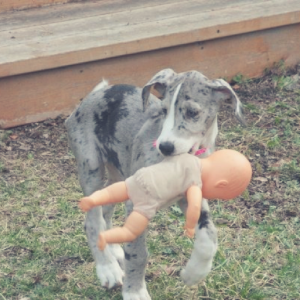

Thank you so much for this post, and attached video. I have had this problem for YEARS with my golden retriever (100 lbs) who has undergone multiple surgeries, lived through being poisoned by Nestle-Purina jerky treats, lived through a car accident, has arthritis, had his spleen removed (due to a tumor), and now is suffering from a cancerous blood-borne disease which is also causing him to have a brain tumor. This dog is now on his 12th life and still enjoying life as best he can. I live alone and therefore it has always been problematic for me to transport him, and exercise him, when he is either injured or recovering from surgery. I’m hoping that this device will allow me to take him on a bucket list vacation before he passes.
Hi Laura. So sorry to hear about everything your Golden has been through. The Help em Up is the only thing we’ve found that lets us safely move our Danes around solo so I really hope it works for you too so you can get through that bucket list with him. Feel free to message or email me with any questions you have about using it, though the videos on their website do a pretty great job of explaining things. Email (or the contact form) will generally be the fastest way to get a response, fyi. Sending good vibes to you both!
Hi Rebecca – sorry i don’t seem to be able to compose a new message – so apologies for riding the coat tails of your reply to another comment.
Wow thank you for sharing this. My dog – Marlon, is a rescue I brought back to the UK (where I am originally from) from Eastern Europe several years ago has the same syndrome as your Great Dane – though not as large (he’s mainly Dutch Shepherd, with a bit of Staffy and Doberman thrown in for good measure 🤪) also has a large head in contrast to his body which is quite squat with broad shoulders – and I suspect has suffered spinal issues from previous owners neglect and abuse – he can’t and has never been able to jump.
While I’ve had the pleasure and honour to know him for the last 6 years (he’s now 14) he has rapidly declined in his ability to walk – and the harness which like you discovered was the best option & I switched to after trialing a collar for around the first 3 days of adopting him – has been very useful but it’s a sort of go between from a standard harness to the specialised one you kindly included as a video in this post.
The harness he has is a mobility one from OneTigris and has two grab handles located above the centre of the shoulder blades and the second slightly further down a few vertebrae towards the tail – but I think now he requires a harness that supports some of his lower body’s back segment – moving closer to his hind legs.
Sorry if this is all waffle – but I just wanted to express my gratitude for you sharing your pup’s story (I love Great Danes too ❤️) and I’m glad ours is on the road to recovery.
Marlon is too old now for surgery – every time he has been put out for a small/minor op – he comes back less the dog than he was before and mentally as he is developing the beginning of Alzheimer’s- I don’t believe he could bounce back from the trauma of surgery.
Again thank you so much for giving this owner some food for thought and practical means of helping moving him around so he can continue to enjoy as much of life as possible with the best quality available.
Best wishes
Hi Jordan, I rarely get in here to check on comments so I just came across yours and I just want to thank you for sharing Marlon’s story. My heart goes out to both of you. We just lost Cash this past winter so we know all too well that balance of keeping them around as long as possible while still making sure they’re as happy and comfortable as they possibly can be. Even though our Danes aren’t around anymore, we still love talking about them and remembering their crazy antics. They’ll always be a big part of our life story and tools like this harness really did help us keep them comfortable and manageable for as long as possible. So glad to hear you found this post helpful. 🙂
Is it really that sturdy that the clip wont snap? How does your dog pee comfortably with the strap near his penis? It looks like a dog can wet it when he/she pees. Looking forward to your reply. Thank you.
Hi Lisa, we’ve been using the harness for several years now and have never had a problem with any of the clips snapping. Our dane, Cash, is about 120lbs now so they are very sturdy.
We’ve used the harness with both male and female danes and for both, we ended up cutting off the the two straps that go from the very back of the butt part of the harness, under their legs and attach at their stomach. Those two straps I think are meant to keep the butt part of the harness from sliding forward, but danes have such deep chests that there’s no risk of it creeping forward if it’s fit properly, and I did find they would get in the way of her pee stream when they were attached. Otherwise, we never had a problem with the rest of the harness every being in the way while she peed.
For our male dane, it sits just behind his penis so we’ve never had a problem with the main part of the harness getting in the way for him either. Every dog is built differently, but the harness seems to be made to sit right in front of their back legs and behind the penis for males. Hope this helps!
I could barely read this, my heart pound and race, I’m so scared of this happening to with me and my pup. He’s 11 year old 100 pound dane/pit mix, with a giant head. He’s had spondolosis (sp?) for years and he has a rod in one of his legs from a broken leg repair when he was 2. He is clearly in some discomfort and I want to be prepared if I need to transport him. He does NOT like to be held closely. Would you suggest I get one of those harnesses to have around? I’m small 5’3, could I lift him?
So sorry for the EXTREMELY late reply. I haven’t checked in on the site in forever and just happened to pop in to update a few things. I’m 5’7″ and the deepest (lowest) part of Dylan’s chest is about 18″ and we’re able to lift her at least a few inches off of the ground with the shoulder strap set to about its middle length. I would think height wise, if you had the strap set to its shortest length you’d be able to lift him…as long as you were strong enough to do so. It’s definitely not easy or fun to haul Dylan around that way, but in an emergency situation, we can do it. I think it would really depend on your personal physical capabilities and how well your pup cooperates. Dylan doesn’t mind being picked up. She just kind of hangs there now cuz she knows what’s going on. It was more difficult at first when she didn’t understand what we were trying to do so not sure how the first few times would go if your guy doesn’t like to be held. Since your post was from almost a year ago, do you mind if I ask how your pup is doing? I won’t be offended if you decide to wait almost a year to reply. 😉
May I ask how Dylan is now? Thank you for sharing your story. Our 11 year old boy has Wobblers and now can’t really support his weight on his own, so was happy to find your recommendation.
Hi Amber! Dylan actually just turned 10 a few weeks ago and she’s doing really well! She has arthritis in all of her knees so we put her on some NSAIDs several months ago so she would have an easier and less painful time getting up and squatting on her own but those have worked out really well and she’s back to her usual lazy self. 🙂 We still use the harness every single time we take her anywhere and even when we get her in and out of the tub, just to be safe. She’s so used to it now that she actually gets excited when we bust it out because she knows something fun is about to happen. I hope it helps you as much as it’s helped us!
Hello,. We have a 150 lbs blue merle Dane who’s starting to have back leg weakness. She has improved some with daily glucosamine and carpofren tabs. At eleven, she feels like, well me sometimes with 3 blown disks myself. I’ve been looking at buying a sewing machine and using sailcloth to make my own harness, but I will be buying the Haynes helper until I learn my sewing skills.
Dr Bob in Reading PA
I hope the harness helps! We still use it every single time we take Dylan anywhere. She’s been on glucosamine and fish oil for years and actually was on carprofen about 5 months ago but had a really severe reaction to it so now she’s on deramaxx, which apparently a lot of other dogs have had sever reactions to but she’s been on it for about 3 months now with no issues and we’ve been getting her a chem panel regularly. Sounds like you’re about in the same boat as we are, but with an extra 50 pounds added. 🙂 Gotta love the giants!
Thank you so much for this, my 80+ pound lab/boxer mix can’t walk and we need to get him to the vet. This has probably saved him from additional injury and also from being very scared. ❤️
Wonderful! I hope he did well with it.
Hi there! We have a similar harness, and the shoulder strap is a life saver! But my question is, how do you safely get your dog out&down from suv? Our 150 lb, 10 y.o. ST Bernard with displastic hip& severe arthritis wants to jump out the back, but obviously we do not want him landing on his joints etc. I’m about your size, and I cannot catch him or reach/hold on to the harness to lessen the blow of impact so to speak…? Ideas? He refuses ramp. And I’m trying-unsuccessfully so far-to get him to use a 2-step down stairs. Thank you for your help&article. I hope your sweet Dane is doing well💚
Hi! I remember with Dylan, I’d do the “lessen the blow” thing with the handles directly on the harness, but Dylan was A LOT lighter. 🙂 This would be a tough one. With our other dane who is a little bigger (still only in the 120lb range) who is now getting older/getting arthritis, we use a ramp in addition to the harness. He was not having it a first, but we got the longest ramp we could find so the incline would be a a subtle as possible, found the widest one we could find (some are crazy narrow), and lured him up and down it a few times with some “high value” treats that he rarely gets. We each stood on either side of him to make him feel more secure so we could catch his bum if he started teetering off it. We’ve used it 3 or 4 times now and he understands the drill now, and knows he’s getting super treats once he’s up it. Were you able to find something to work for your big guy? Sorry about the late response!
Hello. I am puzzled …….how would I be able to lift my 76 pound Shepherd into my medium sized SUV myself with this
harness ? She has DM which has weakened her hind legs and recently tore her ACL on one of them !
It would have worked great prior to her nit being able to put hardly any weight on rear legs since she used to be able to get her front legs into vehicle and I would pick up rear end and push her in. Now she can’t put her front legs in ( they are still strong) since she can’t stand on hind legs. She is too heavy for me to lift up her entire body now !
Any ideas ? Not sure how to get her to a rehab twice a week for her ACL . She is almost 13 so no surgery ….my choice .
Thank you so much
Barb
Hi Barb, sorry about the late reply. And so sorry to hear about your poor girl. Were you able to find anything that works? In our case, we were really lucky that we were strong enough to be able to lift Dylan into the car ourselves using the handles on the harness. Having two people is also a huge help.
My dog is 70#. She had her front leg amputated due to cancer. How do i get her out of my truck? I can get her in but when i try to get her out, even with a sling, she is too heave and i have been knocked down. Luckily, she was not injured. The harness that goes on the front shoulder and the rear looks good, but her surgery is pretty new and it would go right over the incision
Hi Becky, Oh no! That’s a tough situation. I know there are ramps available, some even have a strap you can add to the side so you can use it out of the side door instead of off the tailgate, but either way, she’d need to be able to walk herself a bit. Were you able to come up with anything that worked?
Thank you for this post. So helpful and not much information out there on how to move a large dog in this situation. Me and my dog thank you for taking the time to write about it!
So glad this was helpful, Sarah!
I’ve been googling and came upon this post. Our dog is an English Mastiff and is 207lbs. He needs a growth removed from his fave and we are struggling to figure out how to get him to the vet. We usually have the vet come to our house for shots. He used a ramp in the past but fell off of it so now he won’t even try it. I’m at a loss as to what to do.
Hi Christy,
So sorry your pup is having a hard time. Have you tried the Help ‘Em Up harness mentioned in this post? https://helpemup.com/ There is also quite a bit of additional info in this comments section. Hope you were able to get your big boy to the vet!
Hi Rebecca,
Thanks for giving your first-hand experience. As a Dane owner it’s surprisingly rare to come across emergency prep information specific to large dogs that are harder to move. Question for you: have you had any experience using this harness to pick your dog up from a side-laying position? We were considering having a portable stretcher on hand for emergencies in fear that we’ll find our Dane lethargic and unwilling to get up. He also recently had a procedure with anesthesia and we couldn’t get him to stand up in the car when we arrived home. Do you think this harness would help in lieu of a stretcher? Or would it be best to just go ahead and go for an actual stretcher for my needs?
Hi Layla, Dylan was often laying on her side and it was just a matter of shoving one end of each section of the harness under her to get it around her, and clip everything together. Then we could pick her up once the harness was properly attached, no matter what position she was in. There’s a handle sort of above her shoulder blades and then above her hips, so between those, and the additional shoulder strap you could attach to those, it made it much easier to maneuver her around/through doors/down stairs/etc, especially if there was only one of us doing it.
I imagine if you know you’ll have two people there to manage the stretcher, splitting a dane’s weight between two people is obviously going to be easier to carry, but in our case, and in the case of emergencies/daily potty breaks/etc, we sometimes needed a way to move her with just one person, so the harness was perfect for that.
We also live in an older home so there are a lot of narrow hallways/doorways around corners so there really isn’t an easy straight shot to be able to get her on a stretcher and through a door without having to angle the stretcher in a weird way where she’d likely squirm/fall off. So it probably just depends on what your surroundings are like and how many people you have to work with as to which option might work better. In our case, a stretcher wouldn’t allow us to get through doorways, into the car, or transport her with only one person, but the harness let us do all of those things. Hope this helps!
Rebecca! Thanks so much for this information. About a month ago my 75 pound mix?? hurt his front paw while checking out the woods behind my home. I called my two sons to see if they were available to help me get Jake into the van in the morning. They were not. But in the morning Jake could limp the very short distance to the van.
This got me to thinking of what I would do if he couldn’t get up at all. He is 9 and I’m sure that day will come. My other 9 year old pup is 55 pounds will need assistance also.
Then I thought of what size dog I would rescue when the time came. The larger dogs are always harder to home. But this info has given me some peace of mind that I can handle much more than previously thought with this tool.
Thank you so much for taking the time to tell us your story.
I’m so glad you found it helpful, Linda! I hope your furry kids are doing well!